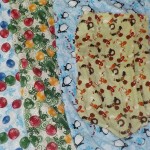The animal world is full of creatures who, as a way of gaining a reproductive advantage, spend precious resources growing extensions and decorations to attract a mate. The incredibly long tail feathers of male peacocks and long-tailed widowbirds can hinder their ability to fly away, but may impressive enough to attract a mate for those males strong enough to survive in spite of the extra weight. Some extra bits are more practical; the male elephant seal’s enormous nose helps him both look more masculine and helps him make big, loud roars that both warn away rivals and attract lady seals. And then there are the various ungulates with antlers and horns; while some females may have smaller versions, the males tend to grow larger sets that are hard to miss.
Here in Oregon, our male native deer and elk are preparing to drop their antlers. This is no small sacrifice; it takes a lot of calcium to grow giant beams of bone on one’s head every year, and still have enough energy to flee predators and put on sufficient weight to get through winter. But after the fall rut, the deer’s testosterone levels drop, which triggers the shedding of antlers.
Why don’t deer just keep their antlers from year to year? Why not keep them, as cattle and most antelopes (with the exception of pronghorn) keep their horns? After all, horns are made of keratin, which is not as costly for a body to manufacture, and they’re hollow sheaths around a living bone core. Simply put, deer and antelopes are from different families in the order Artiodactyla, and while both evolved extensions of their skulls for defense and fighting for breeding rights, the ways in which they developed were different.
There are advantages to losing one’s antlers. Bone is heavy, and carrying bone spikes on your head all winter means you burn more energy. Predation on adult animals is fiercer in winter as well since the more easily hunted young are bigger and more able to defend themselves; losing the extra weight to keep more energy in store may offer a deer just enough extra speed and stamina to escape. While the antlers could be used in defense, deer almost always prefer to run away from danger, in which case the antlers become a hindrance rather than a help.
All this means that for the next few months, the woods and fields of North America (and elsewhere) will be covered in shed antlers. Many of these are chewed up by rodents, who need the calcium they contain. But some will be picked up by humans wandering through, and that’s where things get even more interesting for us.
We’ve used antlers for thousands of years as tools and decoration. Practically speaking, it’s a solid, sturdy material for carving and sharpening, but easier to work than stone. Aesthetically we find antlers to be visually appealing, with their curves and lines catching the eye with ease. And spiritually we frequently use them as altar pieces, head adornments, and symbols of both masculine energy and wilderness in general.
But let’s look at that shedding phenomenon again. While it is pure coincidence that deer and elk shed antlers starting at the beginning of our year, we can take some inspiration from their sacrifice. Many New Year’s resolutions involve removing something from our lives that we no longer need. It may have been useful at some point, but has turned into a hindrance. So, like the antlers that fall from their pedicles to be repurposed by rodents and humans alike, we leave behind old habits and people who are no longer healthy, perhaps to be picked up by those who may find them more fitting.
When you remove something from your life, you don’t have to immediately fill the void left behind. Enjoy the lighter iteration of your life. Antlers grow back slowly, at the pace the animal’s body is able to handle; let your changes happen organically as well, once you’ve made the initial opening in your life.
If you wish to take a ceremonial route, find or buy a single antler; it doesn’t even have to be an especially large one. Even a single tine will do. Think of the habit or other thing that you want to remove from your life as you hold it; then imagine the energy that you’ve put into whatever you’re discarding. Visualize that energy flowing into the antler.
Take the antler to a wild place–a forest or field will do nicely. Place it on the ground, and ask that both the physical antler and the energy it carries be dispersed to where they will be more useful and constructive. As the calcium of the antler is gnawed by rodents, weathered by rain, or even picked up by a wandering explorer, so will the energy you are leaving behind be taken elsewhere where it may do more good.
















